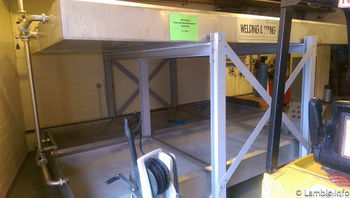Koelschip: Difference between revisions
Added table of coolship specs |
m typo |
||
| Line 14: | Line 14: | ||
{| class="wikitable sortable" | {| class="wikitable sortable" | ||
|- | |- | ||
! Brewery !! | ! Brewery !! Koelschip Material !! Koelschip Volume (total when multiple) (HL)!! Surface Area:Volume (exposed top only, min) (cm<sup>2</sup>:L)!! Actual Surface Area:Volume (exposed top only, estimated) (cm<sup>2</sup>:L)!! Surface Area :Volume (Total SA:Vol, min) (cm<sup>2</sup>:L)!! Brew Size (HL)!! Length (cm)!! Width (cm)!! Height (cm) | ||
|- | |- | ||
| 3 Fonteinen (4) || Stainless Steel || 62.3 || 35.7 || 55.6 || 90.8 || ~40 || 400 || 139 || 28 | | 3 Fonteinen (4) || Stainless Steel || 62.3 || 35.7 || 55.6 || 90.8 || ~40 || 400 || 139 || 28 | ||
Revision as of 00:52, 10 August 2017

A Koelschip is a critical component to the lambic brewing process. Koelschips serve two purposes. The first is to spread the wort across a wide surface area and allow it to cool. The second is to enable spontaneous fermentation by introducing the desirable wild yeasts and microorganisms of the Le Senne Valley to the wort. Koelschips often reside in the brewery's highest most point and are positioned next to slatted windows or other openings to allow open access to the beer.
This process can only happen during the cooler months of the year as molds that can have a negative impact on the beer have a difficult time surviving the cold temperatures. It will take the wort a period of about 10 hours to cool to the desired temperature at which point it will be transferred to barrels. The barrels will help continue the innoculation process as microorganisms can live deep within the wood.
Some breweries such as Mort Subite and Belle Vue don't use a koelschip any more. Mort Subite instead uses the Lebeau Method and Belle Vue uses the DKZ Method.
Koelschips used in lambic breweries
Below is a table based on data collected by Belgian Beer Geek on the characteristics of koelschips in lambic breweries. Volume is calculated from the dimensions, and therefore the practical filling volume is a bit lower. The minimum exposed top surface area to volume ratio is calculated from the top surface and maximum volume. The actual SA:Volume is estimated based on the approximate brew sizes. Total SA:Volume includes the surface area of the sides and bottom of the cool ship. Numbers in parentheses following brewery names indicate the number of identical coolships used by that brewery.
| Brewery | Koelschip Material | Koelschip Volume (total when multiple) (HL) | Surface Area:Volume (exposed top only, min) (cm2:L) | Actual Surface Area:Volume (exposed top only, estimated) (cm2:L) | Surface Area :Volume (Total SA:Vol, min) (cm2:L) | Brew Size (HL) | Length (cm) | Width (cm) | Height (cm) |
|---|---|---|---|---|---|---|---|---|---|
| 3 Fonteinen (4) | Stainless Steel | 62.3 | 35.7 | 55.6 | 90.8 | ~40 | 400 | 139 | 28 |
| Cantillon* | Copper | 75 | 33.3 | 38.5 | 74.7 | 500 | 500 | 30 | |
| Lindemans (new) | Stainless Steel | 234.3 | 19.9 | 23.3 | 46.4 | ~200 | 1113.3 | 419.3 | 50.2 |
| De Troch (2) | Stainless Steel | 57.3 | 38.3 | 68.7 | 88.7 | ~32 | 349.3 | 314.5 | 26.1 |
| Timmermans | Copper | 236.1 | 26.8 | 57.5 | 58.6 | ~110 | 810.1 | 781.3 | 37.3 |
*An extra vessel is available to hold additional wort in case the wort volume exceeds the coolship capacity
- Brasserie Mort Subite - No Coolship Lebeau Method
- Brasserie Belle Vue: No Coolship DKZ Method
Photos
Videos
The videos below show the Cantillon, Timmermans, and Lindemans koelschips being filled.
